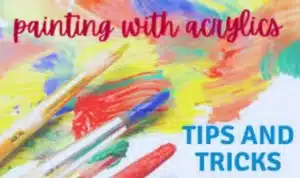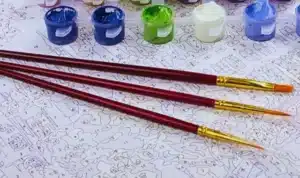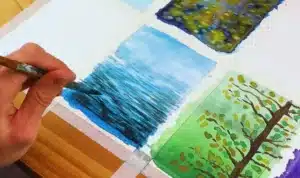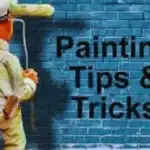Painting is one of the most expressive art forms in human history. From cave drawings thousands of years ago to today’s contemporary canvases, artists have always found creative ways to bring imagination to life through color, strokes, and textures. Whether you are just starting your artistic journey or already have years of experience, improving your skills requires practice, observation, and knowing the right techniques.
In this guide, we will share valuable painting tips and tricks for beginners and professionals to help you refine your craft, avoid common mistakes, and create art that truly stands out.
What is painting
Painting tips and tricks Painting is the art of applying colors, pigments, or other media to a surface such as canvas, paper, or walls to create an image or design. It is both a creative expression and a visual communication form, allowing artists to convey emotions, ideas, and stories through colors, textures, and brushstrokes, blending imagination with technique.
Quick Comparison of Beginner vs. Professional Painting Approaches
| Aspect | Beginners | Professionals |
| Brush Handling | Basic strokes, lack of control | Confident strokes with precision |
| Color Mixing | Struggle with muddy colors | Mastery in blending and harmony |
| Surface Preparation | Often ignored | Thoroughly primes and prepares the canvas |
| Time Management | Rushed painting | Patient, layered approach |
| Attention to Detail | Misses small corrections | Focuses on every fine detail |
Why Painting Skills Matter for Artists
Painting goes beyond applying colors on a canvas; it is a way to express emotions, sharpen focus, and build creative confidence. For beginners, the journey can feel overwhelming when results don’t match expectations. Yet, every mistake opens the door to growth.
For professionals, painting tips and tricks is about refinement and innovation. They use advanced methods to capture realism or create abstract beauty, while constantly experimenting with techniques to keep their artwork original, powerful, and inspiring.
Preparing Your Painting Space
Before diving into techniques, setting up the right environment is important:
- Ensure proper lighting, preferably natural light.
- Keep brushes, palettes, and paints organized.
- Use an easel or flat workspace, depending on your comfort.
- Protect your area with drop cloths or newspapers.
A good setup not only makes painting easier but also keeps you motivated.
Painting Tips and Tricks for Beginners
Beginners often face challenges such as mixing colors, using too much paint, or not knowing how to fix mistakes. Here are some essential painting tips and tricks:
- Start Simple with Basic Shapes: Practice painting tips and tricks circles, squares, and lines before jumping into detailed artworks. This builds hand-eye coordination and brush control.
- Learn the Color Wheel: Understanding primary, secondary, and complementary colors helps you avoid muddy results and create vibrant art.
- Use Limited Colors: Start with a small palette—perhaps red, blue, yellow, black, and white. Limiting your colors teaches you blending skills.
- Practice Layering: Thin layers of paint dry faster and allow you to build depth instead of creating clumps.
- Don’t Fear Mistakes: Every painting mistake is a lesson. Many professional styles emerged from “happy accidents.”
Painting Tips and Tricks for Professionals
For advanced artists, maintaining originality and precision is the real challenge. Here are tips to push your limits:
Experiment with Unusual Tools: Instead of only brushes, use palette knives, sponges, or even household items to create unique textures.
Study Lighting and Shadows: Professional painters often master the play of light, giving paintings realism and mood.
Master Glazing: Apply thin transparent layers of paint to build luminosity and depth, often used in oil painting.
Keep a Reference Collection: Professionals maintain photos, sketches, and art samples to draw inspiration and refine ideas.
Push Your Creativity: Try combining multiple styles—like realism with abstraction—to create signature artworks.
Different Painting Mediums and How to Master Them
Painting is not limited to one medium. Each requires specific handling.
Acrylic Painting Tips
- Work quickly since acrylics dry fast.
- Use water or medium to extend drying time.
- Ideal for beginners due to versatility.
Oil Painting Tips
- Be patient; oil paint dries slowly.
- Practice blending for smooth transitions.
- Use proper ventilation due to strong odors.
Watercolor Painting Tips
- Always use watercolor paper to prevent warping.
- Work from light to dark.
- Control water ratios for different effects.
Digital Painting Tips
- Use layers in software for easy corrections.
- Experiment with brushes and textures.
- Take advantage of color adjustments for fine-tuning.
Common Mistakes to Avoid While Painting
- Using too much paint on the brush.
- Ignoring drying times between layers.
- Overworking the same area until it looks muddy.
- Not cleaning brushes properly.
- Forgetting to step back and view the painting from a distance.
How to Improve Your Painting Skills
Regular Practice: Dedicate at least 20–30 minutes daily. Small but consistent effort leads to long-term improvement.
Take Inspiration from Masters: Study works of Van Gogh, Picasso, Da Vinci, and contemporary artists to understand different approaches.
Join Art Communities: Whether online or offline, engaging with fellow artists helps you gain feedback and motivation.
Try Challenges: Paint within time limits or using only three colors. Such exercises improve adaptability.
Oil painting tips and tricks for beginners
Oil painting is a timeless art form known for its rich textures and vibrant colors, but beginners often struggle with its slow drying process. To start, always work in thin layers, moving from lean to fat, so the paint dries evenly and avoids cracking.
Use quality brushes and remember to clean them thoroughly after each session. Experiment with blending techniques and glazing to achieve depth. Patience is key—take your time to let each layer settle before adding the next.
Painting Tricks to Make Art Stand Out
- Use bold contrasts for eye-catching results.
- Blend edges smoothly for realism.
- Add textures for depth and character.
- Use storytelling—make each painting convey an emotion or narrative.
FAQs: Painting Tips and Tricks
Q1. What are the best painting tips and tricks for beginners?
Ans: Beginners should focus on brush control, understanding the color wheel, and practicing layering. Limiting colors and starting with simple shapes also builds confidence.
Q2. How can professionals improve their painting skills further?
Ans: Professionals can experiment with new media, practice advanced techniques like glazing, and explore different lighting effects. Engaging with communities also brings new perspectives.
Q3. Which medium is best for beginners in painting?
Ans: Acrylic paints are highly recommended for beginners. They dry quickly, are easy to clean, and allow corrections without much hassle compared to oils or watercolors.
Q4. What are common mistakes to avoid when painting?
Ans: Overloading brushes, skipping drying times, ignoring canvas preparation, and overworking areas are typical errors. Being mindful of these can prevent frustration.
Q5. How can I make my paintings more creative?
Ans: Experiment with textures, try unusual tools, use storytelling in your work, and don’t be afraid to combine different art styles to develop your own unique signature.









